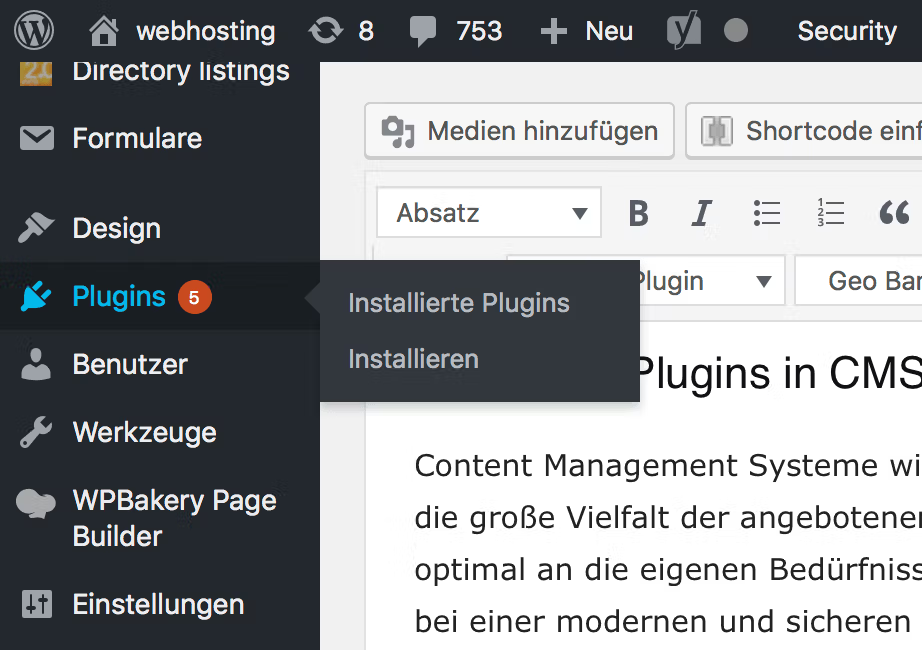Create e-mail address in Plesk
Setting up a new email account in Plesk is easy and requires only a few steps. Follow these instructions to create a new e-mail address:
1. log in to your Plesk interface.
2. navigate to Websites & Domains.
3. click on E-mail and then to E-mail accounts.
4. select Create e-mail address and enter the desired user name and a secure password.
5. select the domain under which the e-mail address is to be set up.
6. optional: Activate the option Can be used to log in to Pleskif the user should also have access to the Plesk panel.
You have successfully created your e-mail account with these steps.
Management of e-mail accounts in Plesk
With Plesk, you can manage various aspects of your email accounts to ensure efficient and secure communication:
- Password change: Change the password for an e-mail account at any time to avoid security risks.
- Automatic responses: Set up automatic responses (e.g. out-of-office notes).
- E-mail forwarding: Forward incoming e-mails to another e-mail address.
- E-mail aliases: Create aliases to bundle several e-mail addresses into a single mailbox.
- Mailbox size: Limit the storage space of a mailbox in order to use server-side resources effectively.
- Outgoing messages: Set a limit for the number of outgoing e-mails per hour to prevent misuse.
These functions are essential, especially for companies that want to maintain a professional and efficient e-mail infrastructure.
Access to e-mail accounts
There are various methods of accessing your e-mail accounts:
- Webmail: You can access your e-mail account at any time via the browser by selecting
webmail.yourdomain.comand enter your login details. - E-mail clients: Programs such as Outlook, Thunderbird or Apple Mail give you access to your emails with advanced management functions.
Correct server settings for e-mail clients
To set up an e-mail account in a client, you need the following IMAP, POP3 and SMTP settings:
- IMAP serverPort 143 (StartTLS) or 993 (SSL/TLS)
- POP3 serverPort 110 (StartTLS) or 995 (SSL/TLS)
- SMTP serverPort 587 (StartTLS) or 465 (SSL/TLS)
The choice between IMAP and POP3 depends on whether you want to keep emails synchronized on several devices (IMAP) or save them locally (POP3).
Security settings for e-mail accounts
Plesk offers numerous security features to protect your email accounts. Use these settings to protect yourself from hackers and spam:
- TLS/SSL encryption: Activate TLS or SSL for encrypted transmission of your e-mails.
- Spam filter: Configure spam filters to minimize unwanted messages.
- DKIM, SPF and DMARC: These mechanisms increase the security of your e-mails and prevent your domain from being misused for fraudulent purposes (phishing).
- Strong passwords: Use complicated passwords and change them regularly.
- Firewall rules: Block unauthorized access to the mail server with strict firewall rules.
Extended e-mail functions in Plesk
In addition to the basic administration options, Plesk also offers advanced functions for optimizing your e-mail system:
Email filters and rules
You can set custom filter rules to organize emails automatically:
- Forward messages with specific keywords directly to selected folders.
- Automatically delete or move spam emails.
- Create rules to place important messages from certain senders in special folders.
Circular mail function for companies
Plesk supports the sending of large volumes of emails, which is useful for companies with regular customer newsletters. Make sure that you comply with legal regulations (e.g. GDPR).
Troubleshooting e-mail problems
If you have difficulties sending or receiving e-mails, check the following points:
- Check the mailbox settings: Make sure that the correct server settings are stored.
- Check storage capacityA full mailbox can mean that no new e-mails are received.
- Test spam filterEmails that do not arrive may be incorrectly marked as spam.
- Check IP blacklistIf your server is on a blacklist, outgoing emails may be blocked.



